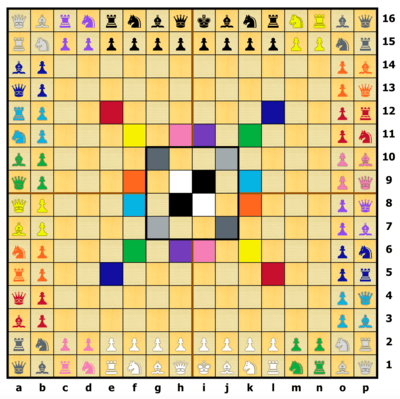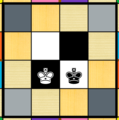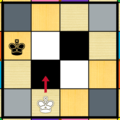Sovereign Chess

Sovereign Chess is a commercial chess variant designed by Mark Bates[1] and produced by Infinite Pi Games.[2] The game is played on a 16 x 16 board and begins with 112 pieces—a normal complement of white and black pieces (16 each), and 80 other colored pieces (8 each of 10 different colors). The colored pieces are considered “neutral” at the beginning of the game, and can not initially be moved nor captured.[3]
The center of the board contains an arrangement of 24 colored squares (2 each in every color, including white and black), which determine control of the neutral armies. In general, these armies are used to supplement a player’s original armies, and to eventually checkmate the opponent.[4][5]
Board Configuration
The board contains 16 rows and 16 columns, for a total of 256 squares, and can also be described as consisting of 8 rings. The first ring consists of the squares on the outer edge of the board (ranks 1 and 16 and files a and p), with subsequent rings moving inward. The eighth ring consists of the center four squares at h8, h9, i8, and i9.
The board contains two squares of each color represented in the game:
Achromatic Colors: White, Ash, Slate, and Black
Chromatic Colors: Pink, Red, Orange, Yellow, Green, Cyan, Navy, and Violet[6]
All colored squares are located near the center of the board (between ranks 5 through 12 and files e through l), but only the achromatic colors are located within the middle 4 x 4 region (between ranks 7 through 10 and files g through j). The pattern of squares has 180-degree symmetry so that each color is equally accessible to each player throughout the game.
At the start of the game, the board contains 112 pieces, filling the first and second rings of the board. There is a regular complement of white and black pieces between files e and l, with white on ranks 1 and 2 and black on ranks 15 and 16.
Each of the chromatic colors have an army of eight pieces, consisting of 1 queen, 1 rook, 1 bishop, 1 knight, and 4 pawns. Each army is divided into two four-piece pods, one with a queen, bishop, and two pawns, and the other with a rook, knight, and two pawns.
The ash and slate armies each have eight pieces, consisting of 2 queens, 2 rooks, 2 bishops, and 2 knights. Each pod has 1 queen, 1 rook, 1 bishop, and 1 knight, located in opposite corners of the board.
Game Play
Essentially, a two player game (White v. Black), Sovereign Chess game play can be summarized as beginning with the utilization of "the pie rule" (White goes first; Black either accepts White's move as their own or makes their own move). Players gain control of other colored armies by landing on squares related to the color of the army. Pawn promotion occurs within the middle 4x4 square.[7]
Sovereign Chess also offers a four-person variant called "Sovereign Chess Royale".[8]
Regime Change
The king, as the protected piece of chess, also represents the leader of a player’s armies. However, in Sovereign Chess, the leadership may change in one of three ways unique to the game: a "owned" pawn promotes to a King (a "Coup d'Etat"), a "controlled pawn promotes to a King (an "Overthrow"), or a player declares their change of control to another color under their control (a "Defection").
All promotion-related regime changes occur within the middle 4x4 grid. There is no limit on the number of regime changes that may take place during the game. A regime change may be used to take an initial king out of check, but may not put the new king into check.
Unusual Situations Created by Rules
Coexisting Kings
If a piece is on a colored square, it is protected from capture by pieces which match the color of the occupied square. Therefore, the legal position exists where the white king can occupy h8 with the black king on i8, and with neither king putting the other in check, as shown in Figure 2.
 Figure 2: Coexisting Kings
Figure 2: Coexisting Kings
Kings Giving Check
It is also possible for a king to put the other king in check, as shown in Figure 3. If the white king moves to h8, he will put the black king in check without fear of capture. However, a possible response for black is to move the king to h9, which will protect it from white.
 Figure 3: King Giving Check
Figure 3: King Giving Check
Limited Pin
Sovereign Chess also introduces positions which are considered “limited pins”. In Figure 4, the black player controls green, with the green rook pinning the white knight. The knight is unable to move, except to capture the black bishop, which would neutralize the threat of the green rook.[9]
 Figure 4: Limited Pin
Figure 4: Limited Pin
In Popular Culture
- A large-scale Sovereign Chess board was designed for all three seasons of the TV show King Of The Nerds, and was used as decoration in "Nerdvana", the general living quarters used by the contestants. Guests - such as Penn Jillette (of Penn and Teller) - can be seen playing beside and interacting with a production version of Sovereign Chess.[10]
External links
- Official website
- Sovereign Chess by Mark Bates, The Chess Variant Pages
References
- ↑ "Meet Mark Bates (CCS Mathematics '90)". UC Santa Barbara College of Creative Studies. University of California Santa Barbara. Retrieved 8 August 2018.
- ↑ "Infinite Pi Games - Board Game Publisher". Board Game Geek. Retrieved 8 August 2018.
- ↑ "List of chess variants: Unorthodox rules on an unorthodox board". Wikipedia. Retrieved 8 August 2018.
- ↑ Mason, Dave. "(Archived Copy) Extreme Chess - Carpinteria resident's game allows players to control extra armies". Santa Barbara News Press. Retrieved 8 August 2018.
- ↑ Mason, Dave. "(Paywall Copy) Extreme Chess - Carpinteria resident's game allows players to control extra armies". Santa Barbara News Press. Retrieved 8 August 2018.
- ↑ "Sovereign Chess is... Novel!". Kickstarter. Retrieved 15 August 2018.
- ↑ "Strategicon: Prototypes and Playtesting". Giant Fire Breathing Robot. Retrieved 15 August 2018.
- ↑ "Sovereign Chess". Board Game Geek. Retrieved 8 August 2018.
- ↑ "Gateway 2013 > Board & Card Games". Strategicon. Strategicon. Retrieved 16 August 2018.
- ↑ "Colorist Tal Perfects the Balancing Act of Color Grading TBS' 'King of the Nerds' with DaVinci Resolve". Production Hub. Retrieved 8 August 2018.